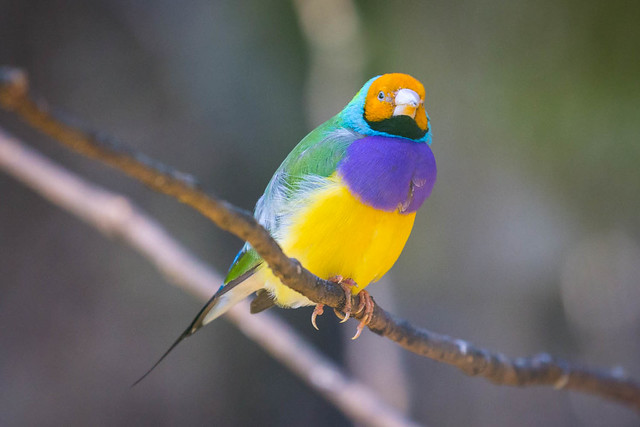UK researchers have shown that highly sociable Australian birds, called Gouldian finches, have different personalities according to the colour of their heads.The team, led by Leah Williams and Dr Claudia Mettke-Hofmann from Liverpool John Moores University, found that red-headed birds have aggressive tendencies, while those with black heads are bold and take more risks than their peers. This is only the second study to show a strong link between personality and colour. "We think that head colour is used as a signal of personality to other birds in the flock, so they know who to associate with," says Williams, who studied the birds as part of her PhD project. Williams and animal personality expert Mettke-Hofmann teamed up with Dr Andrew King from the Royal Veterinary College to find out if colour reflects personality in the endangered Gouldian finch. Gouldian finches have extremely colourful plumage with either red, black, or - rarely - yellow-coloured heads. They live in open, subtropical woodland, where they nest in loose colonies, feeding mainly on grass seeds. Williams, King and Mettke-Hofmann decided to measure three aspects of personality - aggression, boldness and risk-taking - in the finches. They tested the birds' tendency to investigate an unfamiliar object, in this case grey or brown bundles of string dangling from a perch, to find out how bold they were. To test for risk-taking behaviour, they presented both kinds of birds with a cardboard cut-out silhouette of a typical predator like a hawk. For aggression, they put a feeder out for two hungry birds, but the feeder only had room for one bird to eat. They wanted to see which birds would demonstrate aggressive behaviour to get at the food on offer. They found that red-headed birds are quicker to displace each other, or display threatening behaviour with an open beak than the black-headed finches are, exhibiting a fiery personality. They also found that birds with black heads returned to feeders after being shown the hawk silhouette much sooner than red-headed birds did, revealing a risk-taking personality. Black-headed birds were also more likely to approach and touch the string before a red-headed finch would. "We think that having head colour reflect personality means birds can more easily choose who to associate with, and who to avoid in large flocks," says King. The researchers say their findings may explain differences in colours. "Different colours may mean each bird uses different behavioural tactics," says Mettke-Hofmann. "The next step is to find out which birds associate with which. Do reds hang out with reds or blacks and do they do better for that?" asks Williams. The study was funded by the Higher Education Funding Council for England (HEFCE) and the Natural Environment Research Council (NERC). Contacts and sources: Natural Environment Research Council , Leah Williams (primary contact), Liverpool John Moores University, Dr Andrew King, The Royal Veterinary College, Dr Claudia Mettke-Hofmann, Liverpool John Moores University, Source: Nano Patents And Innovations, Image: flickr.com
Climate Adaptation Difficult For Europe’s Birds
For the past 20 years, the climate in Europe has been getting warmer. Species of bird and butterfly which thrive in cool temperatures therefore need to move further north. However, they have difficulty adapting to the warmer climate quickly enough, as shown by new research published in the journal Nature Climate Change. Åke Lindström is Professor of Animal Ecology at Lund University, Sweden. Together with other European researchers he has looked at 20 years’ worth of data on birds, butterflies and summer temperatures. During this period, Europe has become warmer and set temperatures have shifted northwards by 250 km. Bird and butterfly communities have not moved at the same rate. “Both butterflies and birds respond to climate change, but not fast enough to keep up with an increasingly warm climate. We don’t know what the long-term ecological effects of this will be”, says Åke Lindström. Butterflies have adapted more quickly to the changing temperatures and have moved on average 114 km north, whereas birds have only moved 37 km. A likely reason is that butterflies have much shorter lifespans and therefore adapt more quickly to climate change. Because birds like to return to the same breeding ground as in previous years, there is also greater inertia in the bird system. “A worrying aspect of this is if birds fall out of step with butterflies, because caterpillars and insects in general represent an important source of food for many birds”, says Åke Lindström. Sweden shows the strongest trends with regard to birds; however, there is no corresponding Swedish data for butterflies. For the study, the birds have been divided into ‘cold’ and ‘warm’ species, i.e. birds that thrive in slightly cooler or warmer temperatures. For example, chaffinches and reed buntings are ‘colder’ species and blackcaps and goldfinches ‘warmer’ species. In general, the researchers have observed that ‘warm’ birds are on the increase and ‘cold’ birds are in decline. When new species are seen in an area and others disappear, it is more often ‘warm’ species that arrive and ‘cold’ species that disappear. “Over the past 50 years the main factors affecting bird and butterfly numbers and distribution have been agriculture, forestry and urbanisation. Climate change is now emerging as an increasingly important factor in the development of biodiversity”, says Åke Lindström, continuing: “For Sweden, this will probably mean more species of bird in the long run; many new species are already arriving from the continent.” Åke Lindström works among other things on the projects BECC (Biodiversity and Ecosystem Services in a Changing Climate) and CanMove (Centre for Animal Movement Research) at Lund University in Sweden. The study is a joint European project with data from 20 years and seven countries (Spain, France, the Netherlands, Sweden, the UK, Finland and the Czech Republic). The Swedish data covers birds and temperatures and has been gathered on behalf of the Swedish Environmental Protection Agency. Contacts and sources: Åke Lindström, Source: http://www.ineffableisland.com
Subscribe to:
Posts (Atom)


